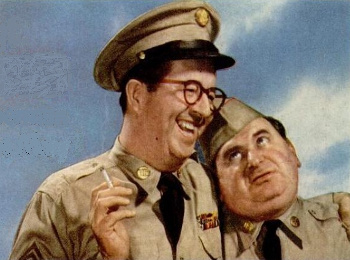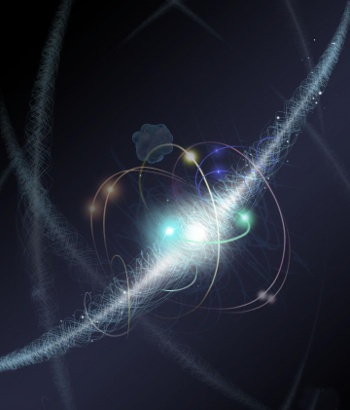Electron Symmetry
December 17, 2018
In the
era when
cigarette smoking was common, there were many
television commercials and
magazine advertisements for cigarette
brands. The
Lucky Strike cigarette brand had a few memorable advertising
slogans, one of which was the
acronym,
LSMFT, for
Lucky Strike Means Fine Tobacco. This was was countered by another brand in "
Winston tastes good like a cigarette should." There was also the 1944 Lucky Strike slogan, "
So round, so firm, so fully packed...," which became the premise of many
sexist jokes.[1]

If the bullets don't get you, the cigarettes will.
Although the health effects of tobacco had been known for many decades and had been scientifically studied,[2] tobacco companies were allowed to send free cigarettes to US troops during World War II.
They encouraged citizens to send cigarettes to troops, and had cigarettes included in soldiers' food packages.
Elektro, a robot produced by Westinghouse for the 1939 New York World's Fair, also smoked cigarettes.
(Camel cigarettes advertisement on the back cover of the July 9, 1956, issue of Life Magazine, featuring Phil Silvers as Sergeant Bilko and Maurice Gosfield as Private Doberman, via Wikimedia Commons.)
The round-firm-fully-packed slogan can be applied also to the
electron. Unlike
composite particles such as the
proton, electrons exhibit no internal structure and act as if they were just
point particles,
elementary particles having
mass,
charge and
spin.
The usual way of finding out how something
works is to break it apart into its individual pieces. I used to do this with my
childhood toys, much to the consternation of my
parents, and later with old
vacuum tube television receivers. Taking apart modern
electronic devices is much less rewarding, since most functionality is hidden within the
epoxy packages of
integrated circuits, or in their undecipherable
software. Likewise, we can't take apart an electron to see what makes it work, since there doesn't appear to be any component parts. I'm too
open-minded to think that there really aren't any; but, for now, we don't think that there are.

Chart of the elementary particles as understood in the Standard Model. Electrons are part of the lepton class that also includes the muon, tau, and their associated neutrinos. Neutrinos were first believed to be massless, but it's now known that they have a mass that's about a million times smaller than that of an electron. (Modified Wikimedia Commons image by MissMJ. Click for larger image.)
One clue to some internal structure to an electron is the uniformity of its
charge distribution; that is, is it indeed perfectly
spherical as would be expected for a point particle. That's why a team of
physicists known as the
ACME Collaboration, ACME being the acronym for
Advanced Cold Molecule Electron, has been searching for a possible
dipole moment for the electron.[3-4] Their
experiment measures small
energy changes caused by a possible electron dipole moment in a
cryogenic molecular beam of
thorium oxide (ThO)
molecules.[5-9] Their current experiments improve by nearly an
order of magnitude on the results of their 2013 study which itself improved by twelve times the results of a previous study.[5]
The primary motivation for the search for a dipole moment in the electron is the validation of the
Supersymmetric Model that proposes the existence of a
superpartner for each known particle. These superpartners would have a spin that differs by a
half-integer from its mate. This
theory goes beyond the Standard Model, which is lacking in some aspects. The Standard Model has not been contradicted by any experiment, although such experiments have been undertaken for decades.[4] Says physicist,
Gerald Gabrielse, a
professor at
Northwestern University, and a member of the research team, "We know the Standard Model is wrong, but we can't seem to find where it's wrong. It's like a huge
mystery novel."
The properties of the ThO
polar molecule amplify the effects of the electron's potential dipole moment.[6] The experiments are so sensitive that if an electron were the
size of the Earth, they would detect if the center of the Earth was displaced by a distance of a few
nanometers.[4] Unlike most particle physics experiments that involve huge
accelerators like the
Large Hadron Collider, this experiment is conducted in a
chamber a few
meters in
diameter.[4]
Lasers are used to excite
energy levels in the molecules, and a
phase-shift would indicate an electric dipole moment.[4,9]
The
null result of the experiment indicates that the supersymmetric particles would have masses much greater than what can be measured at the Large Hadron Collider.[3] These larger masses also indicate that the Supersymmetric Model needs more work.[4] This research was funded by the
National Science Foundation and the
National Institute of Standards and Technology.

An artist's representation of an orbiting electron affected by a background of virtual particles.
Virtual supersymmetric particles would induce a dipole moment on the electron.
(NSF image by Nicolle R. Fuller.)
![]()
References:
- Vintage Lucky Strike Cigarette Commercial - 1948, YouTube Video posted January 16, 2012.
- Raymond Pearl, "Tobacco Smoking and Longevity." Science, vol. 87, no. 2253 (March 4, 1938), pp. 216-217, DOI: 10.1126/science.87.2253.216.
- ACME Collaboration, "Improved limit on the electric dipole moment of the electron," Nature, vol. 562 (October 17, 2018), pp. 355-360, doi:10.1038/s41586-018-0599-8.
- Amanda Morris, "Unprecedented look at electron brings us closer to understanding the universe, Northwestern University Press Release, October 17, 2018.
- The ACME Collaboration, J. Baron, W. C. Campbell, D. DeMille, J. M. Doyle, G. Gabrielse, Y. V. Gurevich, P. W. Hess, N. R. Hutzler, E. Kirilov, I. Kozyryev, B. R. O'Leary, C. D. Panda, M. F. Parsons, E. S. Petrik, B. Spaun, A. C. Vutha, and A. D. West, "Order of Magnitude Smaller Limit on the Electric Dipole Moment of the Electron," Science, vol. 343, no. 6168 (January 17 2014), pp. 269-272, DOI: 10.1126/science.1248213.
- Electron's shapeliness throws a curve at supersymmetry, phys.org, December 19, 2013.
- Andrew Grant, "Electrons' roundness frustrates researchers," Science News, December 19, 2013.
- ACME Collaboration: Jacob Baron, Wes C. Campbell, David DeMille, John M. Doyle, Gerald Gabrielse, Yulia V. Gurevich, Paul W. Hess, Nicholas R. Hutzler, Emil Kirilov, Ivan Kozyryev, Brendon R. O'Leary, Cristian D. Panda, Maxwell F. Parsons, Benjamin Spaun, Amar C. Vutha, Adam D. West, and Elizabeth P. West, "Methods, Analysis, and the Treatment of Systematic Errors for the Electron Electric Dipole Moment Search in Thorium Monoxide," arXiv, December 29, 2016.
- ACME Experiment (narrated), YouTube Video, December 19, 2013.
Linked Keywords: Era; cigarette; smoking; television advertisement; television commercial; magazine; advertisement; brand; Lucky Strike; slogan; acronym; Winston tastes good like a cigarette should; So round, so firm, so fully packed...; sexism; sexist; joke; bullet; health effects of tobacco; decade; science; scientifically; tobacco industry; tobacco company; smoking in the United States military; free cigarettes to US troops; World War II; citizen; military; troops; soldier; food; Elektro; robot; Westinghouse Electric Corporation; 1939 New York World's Fair; Camel cigarettes; Life Magazine; Phil Silvers; The Phil Silvers Show; Sergeant Bilko; Maurice Gosfield; Private Doberman; Wikimedia Commons; electron; composite particle; proton; point particle; elementary particle; mass; charge; spin; childhood; toy; parent; vacuum tube; television set; television receiver; electronics; electronic device; integrated circuit package; epoxy package; integrated circuit; firmware; software; open-mindedness; open-minded; Chart of the elementary particles in the Standard Model; Standard Model; lepton; muon; tau; neutrino; massless; MissMJ; charge density; charge distribution; sphere; spherical; physicist; ACME Collaboration; electric dipole moment; experiment; energy; cryogenics; cryogenic; molecular beam; thorium; oxide; molecule; order of magnitude; Supersymmetry; Supersymmetric Model; superpartner; half-integer; theory; Gerald Gabrielse; professor; Northwestern University; mystery fiction; mystery novel; polar molecule; amplitude; amplify; Earth radius; size of the Earth; nanometer; particle accelerator; Large Hadron Collider; vacuum chamber; meter; diameter; laser; energy level; phase (waves); phase-shift; null result; National Science Foundation; National Institute of Standards and Technology; artist's impression; artist's representation; atomic orbital; orbiting electron; virtual particle; Nicolle R. Fuller.